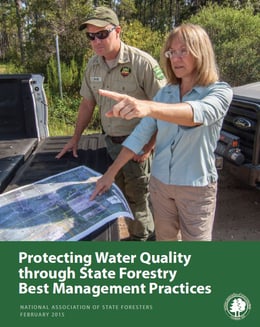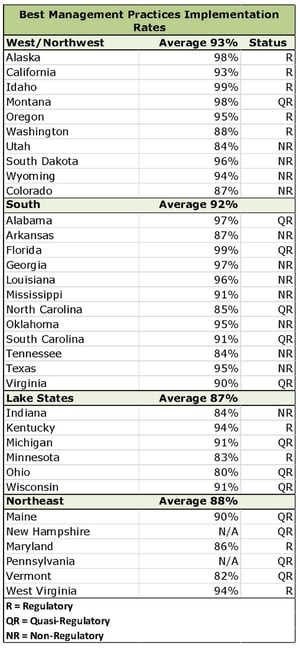The National Association of State Foresters (NASF) recently published its report on forestry best management practices (BMPs) for maintaining water quality—a comprehensive summary of BMP activity by state aptly timed to be released in conjunction with Earth Day 2015. Seasoned industry veterans will glean helpful information from its pages, but the report also serves the larger forest-products industry by offering a certain level of transparency into the business of forest management, as well as the regulatory oversight process. It provides tangible industry data, key findings and recommendations, and raises public awareness for the responsible silviculture practices that have become industry standards.
 Best management practices (BMPs) include the guidelines set forth by individual states to ensure compliance with the Clean Water Act.* These practices are outlined in detail and are widely available, as is the training required for applying the practices.
Best management practices (BMPs) include the guidelines set forth by individual states to ensure compliance with the Clean Water Act.* These practices are outlined in detail and are widely available, as is the training required for applying the practices.
As NASF states, “BMPs are effective, affordable, and practical measures implemented to protect water quality when undertaking silvicultural activities. Forestry BMPs have been evaluated, tested, revised, and adapted over time by each state. Forestry BMPs are inherently linked to water quality. The CWA recognizes BMPs as the most viable pathway to address nonpoint source pollution that originates from various land management activities.”
In short, BMPs are designed to protect bodies of water through the definition of Streamside Management Zones (SMZs) or Riparian Management Zones (RMZs), or strips of land adjacent to streams, lakes or other bodies of water in which forestry operations may impact water quality. BMPs outline the size of these zones, recommend best practices for constructing stream crossings, forest roads and skid trails, and detail the steps that should be undertaken to minimize pollution risks. In addition, BMPs sometimes include limits on fertilizers and pesticides as well as waste disposal.
To gain a broader understanding of how regulatory action affects BMP enforcement and implementation over time, NASF also categorizes the data by state regulatory status (as noted in the chart below). NASF adds, “These implementation results were produced using a variety of approaches. Eleven states have some form of a forest practices law or silvicultural BMP legislation. Twenty states are strictly voluntary and promote the use of BMPs through training and education. Nineteen programs are quasi-regulatory, in that state law specifies a desired outcome (for example, no degradation of water quality), but does not prescribe the BMPs to be used.”
The following chart outlines compliance levels for states with significant forest resources and harvest activity by region. The data is included in the newly-published NASF report and is the most current information available.

While individual states have made noticeable improvements since our last report on BMPs, the regional trends remain unchanged: The West/Northwest region has the highest level of compliance with an average of 93 percent; the South follows with an average of 92 percent.; the Lake States have an 87 percent rate, and the Northeast has a rate of 88 percent (current data for two of the six Northeastern states is unavailable).
Some of the individual state numbers have been updated in the new NASF report and notable improvements include:
-
Kentucky: increase from 68 to 94 percent
-
Maine: increase from 75 to 90 percent
-
Minnesota: increase from 71 to 83 percent
-
Vermont: increase from 68 to 82 percent
-
West Virginia: increase from 84 to 94 percent
The high compliance rates in most states demonstrate that the forestry industry continues to do an excellent job of protecting the water sources in the forests in which it works. Overall, 20 of the 32 reporting states (62 percent) had implementation rates of 90 percent or higher, which highlights the successful implementation of BMPs on a national level.
For companies that are considering opening new operations, choosing sites in states with the highest implementation of best practices can minimize the amount of risk associated with water pollution. By maintaining working environments that incorporate BMPs as standard operating procedures, companies can also mitigate safety concerns and promote sound environmental stewardship. For practical purposes, BMPS are good for both business and forests.
If you've seen updated compliance numbers for states not included in the newest NASF report, please let our readers know by leaving a comment.
*Enacted in 1972, the Clean Water Act had significant ramifications for forest and harvest management practices. For the first time, the act required non-point sources (NPS) of water pollution to take proactive steps to minimize the effects of operations on water quality. According to the US Environmental Protection Agency (EPA):
Nonpoint source pollution generally results from land runoff, precipitation, atmospheric deposition, drainage, seepage or hydrologic modification.
The term "nonpoint source" is defined to mean any source of water pollution that does not meet the legal definition of "point source" in section 502(14) of the Clean Water Act. That definition states: The term "point source" means any discernible, confined and discrete conveyance, including but not limited to any pipe, ditch, channel, tunnel, conduit, well, discrete fissure, container, rolling stock, concentrated animal feeding operation, or vessel or other floating craft, from which pollutants are or may be discharged. This term does not include agricultural storm water discharges and return flows from irrigated agriculture. (The second post in this series will look at point sources of pollution.)
States report that nonpoint source pollution is the leading remaining cause of water quality problems. The effects of nonpoint source pollutants on specific waters vary and may not always be fully assessed. However, we know that these pollutants have harmful effects on drinking water supplies, recreation, fisheries and wildlife.
Sediment from improperly managed forests is considered a nonpoint source of pollution. Following the enactment of the CWA, states were required to comply with the law. In response, 44 states have recommended or required best management practices (BMPs) for forestry related activities to ensure compliance with the CWA.
For an overview of BMPs by region, we recommend the National Council for Air and Stream Improvement’s (NCASI), “Compendium of Forestry Best Management Practices for Controlling Nonpoint Source Pollution in North American.”





